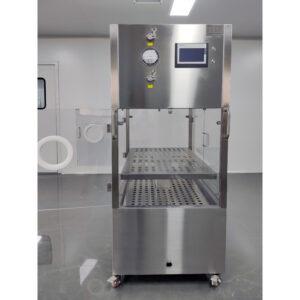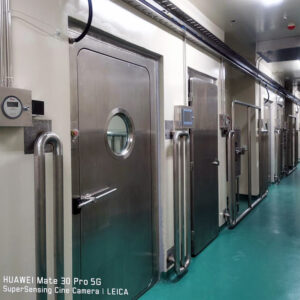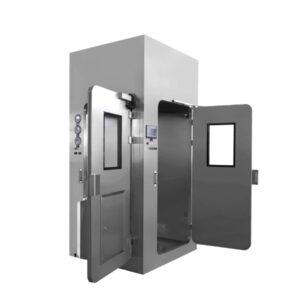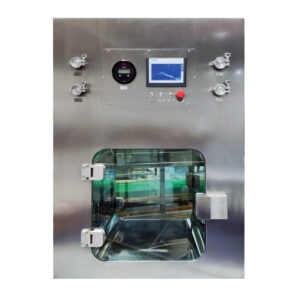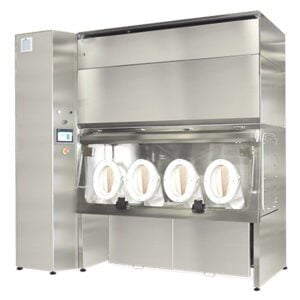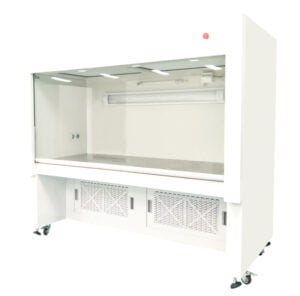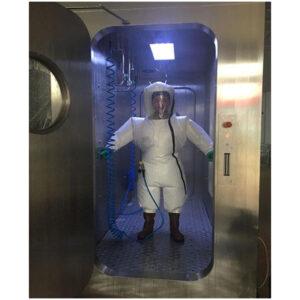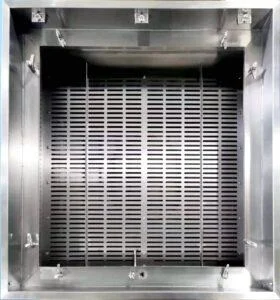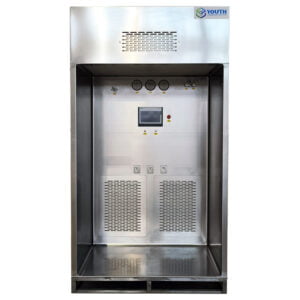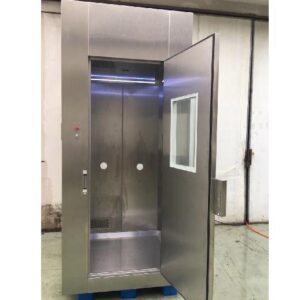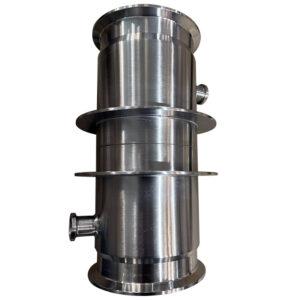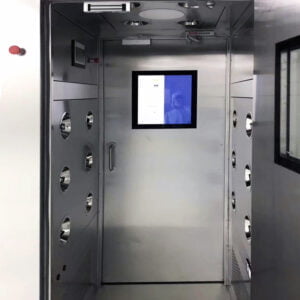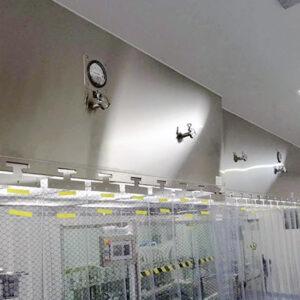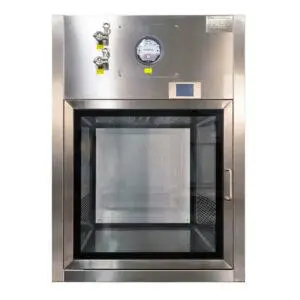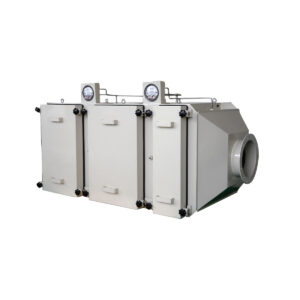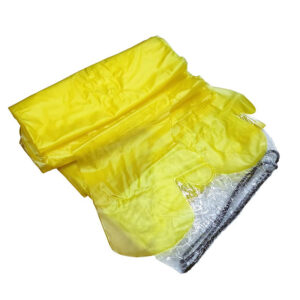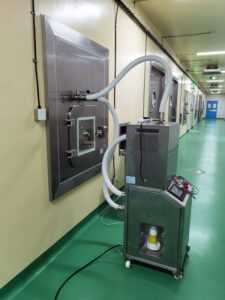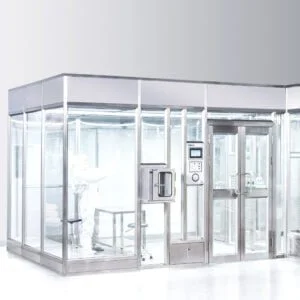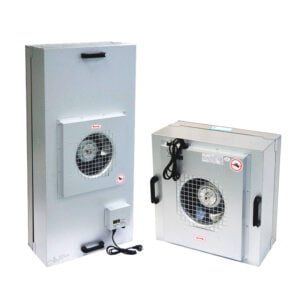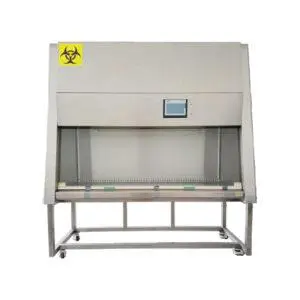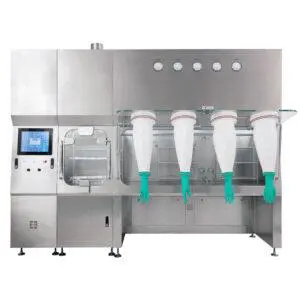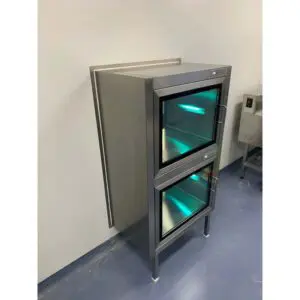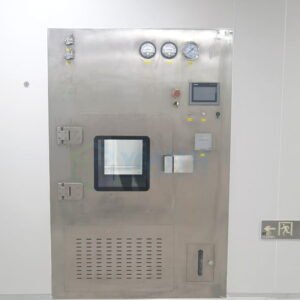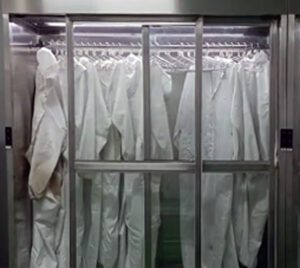In the ever-evolving landscape of pharmaceutical manufacturing, maintaining sterile environments is paramount. Vaporized Hydrogen Peroxide (VHP) distribution systems have emerged as a game-changing technology, revolutionizing the way large-scale pharmaceutical facilities approach cleanroom sterilization. This innovative method offers unparalleled efficiency, effectiveness, and versatility in ensuring the highest standards of cleanliness and contamination control.
VHP distribution systems utilize hydrogen peroxide vapor to decontaminate surfaces and spaces, providing a powerful yet environmentally friendly solution for maintaining sterile conditions. These systems have gained widespread adoption in pharmaceutical facilities due to their ability to penetrate even the most hard-to-reach areas, their rapid cycle times, and their compatibility with a wide range of materials and equipment. As the industry continues to evolve, VHP technology is playing an increasingly crucial role in meeting stringent regulatory requirements and optimizing production processes.
As we delve deeper into the world of VHP distribution systems, we'll explore their key components, operational principles, and the myriad benefits they offer to large-scale pharmaceutical facilities. From improving operational efficiency to enhancing product quality and safety, these systems are reshaping the landscape of cleanroom technology and setting new standards for sterile manufacturing environments.
"VHP distribution systems have revolutionized cleanroom sterilization in pharmaceutical facilities, offering a more efficient, effective, and environmentally friendly alternative to traditional methods."
Table: Comparison of Sterilization Methods in Pharmaceutical Facilities
| Method | Effectiveness | Cycle Time | Material Compatibility | Environmental Impact |
|---|---|---|---|---|
| VHP | High | Short | Excellent | Low |
| Steam | High | Long | Limited | Moderate |
| EtO | High | Very Long | Good | High |
| UV | Moderate | Short | Limited | Low |
How do VHP distribution systems work?
At the heart of VHP technology lies a sophisticated process that transforms liquid hydrogen peroxide into a powerful sterilizing vapor. The system begins by vaporizing a concentrated hydrogen peroxide solution, typically 30-35%, into a fine mist. This vapor is then distributed throughout the target area using carefully designed nozzles and air handling systems.
The VHP distribution process is carefully controlled to ensure optimal concentration and coverage. Advanced sensors monitor the vapor concentration, humidity, and temperature in real-time, allowing for precise adjustments to maintain ideal sterilization conditions. This level of control is crucial for ensuring consistent and reliable results across various facility layouts and environmental conditions.
One of the key advantages of VHP systems is their ability to penetrate even the most complex geometries and hard-to-reach spaces. The vapor can easily seep into crevices, around equipment, and through HVAC systems, providing comprehensive coverage that traditional cleaning methods often struggle to achieve.
"VHP distribution systems utilize advanced sensors and control mechanisms to maintain optimal sterilization conditions, ensuring consistent and reliable results across diverse facility environments."
| VHP Distribution System Component | Function |
|---|---|
| Vaporizer | Converts liquid H2O2 to vapor |
| Distribution Nozzles | Disperses vapor throughout the space |
| Sensors | Monitor vapor concentration and environmental conditions |
| Control System | Adjusts parameters for optimal sterilization |
| Catalytic Converters | Breaks down H2O2 into water and oxygen post-cycle |
What are the key benefits of VHP distribution systems for pharmaceutical facilities?
VHP distribution systems offer a multitude of advantages that make them particularly well-suited for large-scale pharmaceutical facilities. One of the most significant benefits is their rapid cycle times. Unlike traditional sterilization methods that can take hours or even days, VHP systems can complete a full decontamination cycle in as little as a few hours, significantly reducing downtime and improving operational efficiency.
Another crucial advantage is the system's compatibility with a wide range of materials and equipment. VHP is non-corrosive and doesn't leave residues, making it safe for use with sensitive electronic equipment, delicate instruments, and various pharmaceutical materials. This versatility allows for comprehensive sterilization without the need for time-consuming equipment removal or special protective measures.
Environmental considerations are also a key factor in the growing popularity of VHP systems. The process breaks down into water vapor and oxygen, leaving no toxic residues. This makes VHP an environmentally friendly alternative to traditional chemical sterilants, aligning with the pharmaceutical industry's increasing focus on sustainability and reducing environmental impact.
"The rapid cycle times, material compatibility, and environmental friendliness of VHP distribution systems make them an ideal choice for large-scale pharmaceutical facilities seeking to optimize their sterilization processes."
| Benefit | Impact on Pharmaceutical Operations |
|---|---|
| Rapid Cycle Times | Reduced downtime, increased production capacity |
| Material Compatibility | Comprehensive sterilization without equipment damage |
| Environmental Friendliness | Reduced chemical waste, improved sustainability |
| Efficacy | High kill rate for wide range of microorganisms |
| Versatility | Suitable for various facility layouts and applications |
How do VHP systems integrate with existing facility infrastructure?
Integrating VHP distribution systems into existing pharmaceutical facilities requires careful planning and expertise, but the results can be transformative. Modern VHP systems are designed to seamlessly interface with building automation and HVAC systems, allowing for centralized control and monitoring of the sterilization process across multiple areas of a facility.
The integration process typically begins with a thorough assessment of the facility's layout, airflow patterns, and existing infrastructure. This information is used to design a custom VHP distribution network that ensures optimal coverage and efficiency. YOUTH offers portable VHP generator units that can be easily integrated into existing cleanroom setups, providing flexibility and scalability for facilities of various sizes.
One of the key considerations in VHP system integration is the coordination with HVAC systems. Proper airflow management is crucial for ensuring even distribution of the vapor and maintaining the required concentration levels. Advanced VHP systems can be programmed to work in tandem with HVAC controls, automatically adjusting airflow and pressure differentials during the sterilization cycle.
"Successful integration of VHP distribution systems requires careful coordination with existing facility infrastructure, particularly HVAC systems, to ensure optimal performance and coverage."
| Integration Aspect | Consideration |
|---|---|
| Facility Assessment | Evaluate layout, airflow, and existing systems |
| Distribution Network Design | Custom-designed for optimal coverage |
| HVAC Coordination | Synchronize with airflow management systems |
| Control System Integration | Interface with building automation systems |
| Safety Measures | Implement safeguards and monitoring protocols |
What safety considerations are important when implementing VHP systems?
While VHP distribution systems offer numerous benefits, it's crucial to implement proper safety measures to protect personnel and ensure reliable operation. One of the primary safety considerations is the handling and storage of hydrogen peroxide, which is typically used in concentrated form. Proper training, protective equipment, and storage protocols are essential to minimize the risk of accidental exposure or spills.
During the sterilization process, it's critical to ensure that the treated areas are properly sealed and that personnel are evacuated. Advanced VHP systems incorporate multiple safety features, including door interlocks, vapor detection sensors, and emergency shutdown mechanisms. These systems continuously monitor vapor concentrations and can automatically abort the cycle if any anomalies are detected.
Post-cycle safety is equally important. Most modern VHP systems include a catalytic conversion phase that breaks down any remaining hydrogen peroxide into water and oxygen. This ensures that the treated areas are safe for re-entry without the need for extensive aeration periods. However, it's still crucial to follow proper re-entry protocols and verify that vapor levels have returned to safe levels before allowing personnel to enter the sterilized spaces.
"Comprehensive safety protocols, including proper training, advanced monitoring systems, and post-cycle verification procedures, are essential for the safe and effective implementation of VHP distribution systems in pharmaceutical facilities."
| Safety Aspect | Measure |
|---|---|
| Chemical Handling | Proper storage, PPE, and spill response procedures |
| Process Control | Automated monitoring and emergency shutdown systems |
| Area Isolation | Sealing and evacuation procedures during cycles |
| Post-Cycle Verification | Catalytic conversion and re-entry protocols |
| Personnel Training | Comprehensive safety and operational training programs |
How does VHP technology compare to traditional sterilization methods?
When comparing VHP technology to traditional sterilization methods such as steam, ethylene oxide (EtO), or formaldehyde, several key differences emerge. VHP offers a unique combination of efficacy, speed, and versatility that sets it apart from these conventional approaches.
One of the most significant advantages of VHP is its rapid cycle times. While steam sterilization can take hours and EtO cycles can last up to 24 hours or more, VHP cycles can be completed in as little as 2-3 hours. This dramatic reduction in cycle time translates to increased operational efficiency and reduced downtime for pharmaceutical facilities.
Material compatibility is another area where VHP excels. Unlike steam, which can damage heat-sensitive materials, or EtO, which can leave toxic residues, VHP is safe for use with a wide range of materials, including electronics, plastics, and sensitive pharmaceutical ingredients. This versatility allows for more comprehensive sterilization without the need for time-consuming equipment removal or special protective measures.
"VHP technology offers a superior balance of efficacy, speed, and material compatibility compared to traditional sterilization methods, making it an increasingly popular choice for modern pharmaceutical facilities."
| Sterilization Method | Cycle Time | Material Compatibility | Residues | Environmental Impact |
|---|---|---|---|---|
| VHP | 2-3 hours | Excellent | None | Low |
| Steam | 4-6 hours | Limited | Moisture | Moderate |
| EtO | 12-24+ hours | Good | Toxic | High |
| Formaldehyde | 6-12 hours | Good | Toxic | High |
What regulatory considerations apply to VHP distribution systems in pharmaceutical facilities?
The implementation of VHP distribution systems in pharmaceutical facilities is subject to various regulatory considerations, reflecting the critical role these systems play in maintaining product quality and safety. Regulatory bodies such as the FDA, EMA, and WHO have established guidelines and standards that govern the use of sterilization technologies in pharmaceutical manufacturing.
One of the key regulatory requirements is validation of the VHP sterilization process. This involves demonstrating that the system consistently achieves the required level of microbial reduction across all treated areas. Facilities must develop and implement robust validation protocols, including installation qualification (IQ), operational qualification (OQ), and performance qualification (PQ) studies.
Another important regulatory aspect is the integration of VHP systems into the facility's overall contamination control strategy. This includes developing standard operating procedures (SOPs), establishing monitoring and documentation practices, and implementing a comprehensive quality management system. Regular revalidation and performance monitoring are also typically required to ensure ongoing compliance and effectiveness.
"Regulatory compliance for VHP distribution systems requires comprehensive validation, integration into contamination control strategies, and ongoing monitoring to ensure consistent performance and adherence to cGMP standards."
| Regulatory Aspect | Requirement |
|---|---|
| Process Validation | IQ, OQ, PQ studies |
| SOPs | Detailed procedures for operation and maintenance |
| Monitoring | Continuous performance tracking and documentation |
| Quality Management | Integration with overall quality systems |
| Revalidation | Periodic reassessment of system performance |
How can pharmaceutical facilities optimize their VHP distribution systems for maximum efficiency?
Optimizing VHP distribution systems is crucial for maximizing their effectiveness and efficiency in pharmaceutical facilities. One key strategy is to conduct regular performance assessments and fine-tune the system parameters based on the specific requirements of different areas within the facility. This may involve adjusting vapor concentrations, cycle times, or distribution patterns to achieve optimal results while minimizing resource consumption.
Integration with facility management systems can also significantly enhance efficiency. Advanced VHP systems can be programmed to automatically initiate sterilization cycles based on production schedules or environmental monitoring data. This automation not only reduces the burden on personnel but also ensures that sterilization processes are consistently executed at the most appropriate times.
Implementing a preventive maintenance program is another critical aspect of system optimization. Regular inspections, calibrations, and component replacements can help prevent unexpected downtime and ensure consistent performance. Many modern VHP systems include self-diagnostic capabilities and predictive maintenance features that can alert operators to potential issues before they impact operations.
"Continuous optimization of VHP distribution systems through performance assessments, automation, and preventive maintenance is essential for maximizing efficiency and ensuring consistent sterilization results in pharmaceutical facilities."
| Optimization Strategy | Benefits |
|---|---|
| Parameter Fine-tuning | Improved efficacy and resource efficiency |
| System Integration | Enhanced automation and scheduling |
| Preventive Maintenance | Reduced downtime and consistent performance |
| Performance Monitoring | Data-driven optimization and troubleshooting |
| Staff Training | Improved operational efficiency and compliance |
In conclusion, VHP distribution systems have revolutionized cleanroom sterilization in large-scale pharmaceutical facilities. Their rapid cycle times, material compatibility, and environmental friendliness make them an ideal choice for modern manufacturing environments. As the industry continues to evolve, VHP technology is poised to play an increasingly crucial role in maintaining the highest standards of cleanliness and contamination control.
The successful implementation of VHP systems requires careful consideration of integration challenges, safety protocols, and regulatory requirements. However, the benefits of improved operational efficiency, enhanced product quality, and reduced environmental impact make the investment in this technology well worth the effort.
As pharmaceutical facilities look to the future, optimizing their VHP distribution systems will be key to staying competitive and meeting ever-increasing quality standards. By leveraging advanced automation, data-driven optimization, and comprehensive maintenance strategies, facilities can unlock the full potential of VHP technology and set new benchmarks for cleanroom sterilization.
External Resources
STERIS Launches Two New Systems for Integrated VHP Facility Decontamination – This article discusses the launch of STERIS's new VHP 100i and 1000i systems, designed for integration into a facility's building automation and HVAC systems, providing efficient and frequent decontamination in pharmaceutical, medical device, and research environments.
Vaporized Hydrogen Peroxide Sterilization: STERIS VHP Technology – This resource provides an in-depth look at STERIS VHP technology, its applications in healthcare, pharmaceuticals, and research, and highlights its benefits such as rapid cycle times, precise control, and environmental friendliness.
Nephron Pharmaceuticals Compounding Facility Integrates VHP Biodecontamination – This case study details Nephron Pharmaceuticals' experience with integrating VHP biodecontamination systems to reduce manual disinfection time and meet aseptic standards in their production spaces.
VHP Decontamination Chamber MD-C – PBSC Inc – This page describes the VHP decontamination chamber by PBSC, which is designed for material production environments and high containment applications, offering features like intuitive operation, precise control, and environmental friendliness.
Guide to Implementing a VHP System for Facility Biodecontamination – This guide from STERIS provides tips and considerations for implementing VHP systems in cleanrooms and other facilities, including the types of VHP equipment, integration with HVAC systems, and necessary services for implementation and maintenance.
Vaporized Hydrogen Peroxide (VHP) for Biodecontamination in Pharmaceutical Facilities – This article explores the use of VHP for biodecontamination in pharmaceutical facilities, discussing its effectiveness, advantages over traditional methods, and its integration into facility operations.
- Biodecontamination Using Vaporized Hydrogen Peroxide in Pharmaceutical Cleanrooms – This resource focuses on the application of VHP in pharmaceutical cleanrooms, including the process of biodecontamination, the role of HVAC systems, and the benefits of using VHP in maintaining sterile environments.
Related Contents:
- Vaporized Hydrogen Peroxide Sterilization: Principles and Applications
- Vaporized Hydrogen Peroxide vs Traditional Sterilization: A Comprehensive Analysis
- Vaporized Hydrogen Peroxide: Revolutionizing Pharmaceutical Decontamination
- VHP Generator Integration: Enhancing Cleanroom Efficiency
- Vaporized Hydrogen Peroxide: The Future of Sterilization
- Vaporized Hydrogen Peroxide Sterilization: STERIS VHP Technology
- Optimizing VHP Cycles for Cleanroom Decontamination
- Regulatory Compliance for VHP Sterilization in Pharmaceutical Manufacturing
- Vaporized Hydrogen Peroxide: Revolutionizing Aseptic Processing

